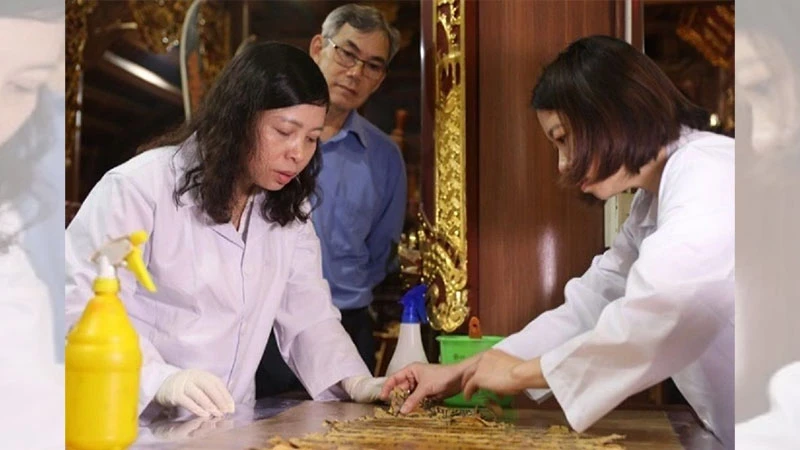Tran Dang Phuong from the National Archives Centre under the Department of State Records and Archives still vividly remembers the process of restoring six ordination documents at Than My Tho Communal House in My Tho Town, Cao Lanh District, Dong Thap Province. On April 14, 2017, representatives from the Than My Tho Communal House handed over an ordination document that was severely damaged, sticky, and clumpy, to the centre’s officers.
Phuong said this was the most severely damaged document that people have ever asked the centre to fix. The centre's staff carefully opened and peeled off the ordination document little by little. Sometimes, the work seemed to be at a standstill, but they encouraged each other to persevere. The centre also consulted with leading Japanese experts, thereby reaching an agreement that the method of approach would be as basically the same as for the Nguyen Dynasty's imperial records.
“We cannot forget the emotions of the participants when the documents gradually appeared,” said Phuong. On July 9, 2020, after exactly 3 years and 3 months, the ordination records of Than My Tho Communal House were "revived" with relatively complete initial information.
The story mentioned above is just an example of the diverse hardships that those who work on restoring ancient documents must face. Under the impact of time, war, weather, and many other harmful factors, it is difficult to avoid documents becoming seriously damaged. In addition, the variety of materials used to provide information and the method of recording information has also created countless different difficulties.
Many families, individuals, and worship facilities consider documents as treasures, so they have preserved them very carefully. However, they have not known how to preserve them, causing many documents, especially Sino-Nom ones, to be destroyed.
As time passes, documents are more degraded, so the process of restoration and repair is like a race against time. However, in reality, along with the challenges in finding technical solutions to handle the physical condition of documents, archivists also have to face obstacles stemming from the psychology of those who own documents.
In particular, a common obstacle is people's anxiety when touching ancient and sacred documents. How to make people feel secure and confident in accessing and restoring these documents is not simple. Sharing at the seminar entitled “Preserving and restoring archival documents – to make memories always revived” recently organised by the National Archives Centre I, Pham Xuan Phuong, former Chairman and Head of the cooperation and scientific research project on collecting and digitising Sino-Nom documents from villages, communes and private homes in Thua Thien Hue Province (2009-2021), said that under the principle of many villages and families, when opening the box of ordination documents and records, all rituals must be carried out with the participation of all the village's leaders and representatives of the families.
Faced with this reality, many experts believe that in addition to investment in resources improve techniques and expertise for staff working on repairing and restoring documents at museums, libraries, and archives, it is important to raise public awareness and consciousness of the value of archives as well as the method of preserving archives.
Phuong asked the localities to coordinate with archive centres to organise training courses on preserving documents especially Sino-Nom documents for worship facilities, individuals, and families. The purpose of the training courses is to provide information about documents as well as the preservation, exploitation, and use of documents, thereby raising people’s awareness of preserving and prolonging the life of precious documents.
Regarding the safe preservation of documents after restoration among the people, Phuong said it should be conducted according to the direction of “State and people working together” because after the restoration, although the physical condition of the documents may be improved, they cannot be like new, so the preservation and use need to be carried out according to appropriate solutions. From the perspective of security and fire prevention, worship facilities and people's houses are not safe places to preserve rare documents.
In fact, at many worship facilities across the country, many ordinations have been stolen or destroyed in fires. Therefore, precious documents should be preserved in specialised archives in the form of consignment or donation. Worship facilities can use the versions to serve traditional rituals.
Many experts said the current potential for documents stored by individuals, families, clans, and worship facilities is huge. To promote the value of these documents, staff working in historical archives need to increase field trips to households to propagate and disseminate the significance of the preservation and restoration of documents as well as encourage them to declare, donate, or consign precious documents to the archive centres. In addition, it is crucial to issue policies to promptly recognise and encourage people to voluntarily consign or donate the documents.
















